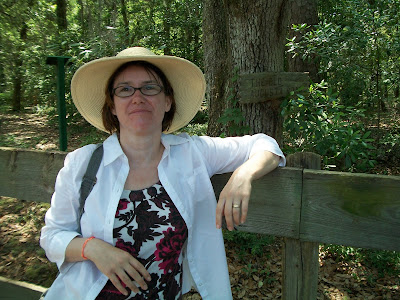I had such grandiose plans for my time in Savannah.
 I was going to read the Wilmington Journal from 1860-1865, do all the readings for the seminar (and more). I was going to write a research plan to guide me as I move forward with thinking about for the antebellum and Civil War in the Cape Fear.
I was going to read the Wilmington Journal from 1860-1865, do all the readings for the seminar (and more). I was going to write a research plan to guide me as I move forward with thinking about for the antebellum and Civil War in the Cape Fear.Oh, how naive I was!
Time has flown. We've read 600-800 pages of stuff a week, talked about the readings, listened to guest speakers' takes on the war era, and gone on field trips in the hot sun.
 The group has also done a lot of outside-the-seminar talking: about the Civil War, slavery, Savannah, about where to go to dinner, and about the crummy state of the current economy.
The group has also done a lot of outside-the-seminar talking: about the Civil War, slavery, Savannah, about where to go to dinner, and about the crummy state of the current economy.Family and friends have visited, so I haven't been at it 24/7, and I've done a bunch of touristy things, like taking the obligatory photo at Forsyth Park, and going to Bonaventure Cemetery.
 Plus, I have spent a little time at one particularly delightful Savannah watering hole.
Plus, I have spent a little time at one particularly delightful Savannah watering hole. And so, here I am, with one week left, at it is only May 1861.
And so, here I am, with one week left, at it is only May 1861.It seems fitting, though, when I really think about it. The Civil War literature is huge, the topic is multifaceted, and to do it justice I really do need to spend some serious time on it.
So, although there will still be miles to go before I sleep when I leave here, I'm excited by all the ideas I've got circling in my head. It will be interesting to see where the next months of research and reading take me when I get home to Wilmington.
Just to give you a flavour, in case you are interested, here's the Wilmington Journal 's take on an event in January 1861. Now remember, North Carolina is still in the Union, and the state does not secede until May 1861.
Still, when the residents of Brunswick county occupied Fort Caswell in anticipation of the state's secession, the paper supported taking control of a federally owned piece of property. It declared:
This is a fascinating way to justify the actions of people who are breaking the law. And it is written by the editor (I assume) of a paper that often complains about the North's lack of resepct for slaveholders' property rights.
It is also just one of the many articles that have caught my eye over the last three weeks. So, perhaps I should be amazed that I'm even at secession.
∞∞∞∞∞


























 They were often British -- I imagine them with their English or Celtic pallor -- so they weren't exactly used to heat and humidity.
They were often British -- I imagine them with their English or Celtic pallor -- so they weren't exactly used to heat and humidity.





